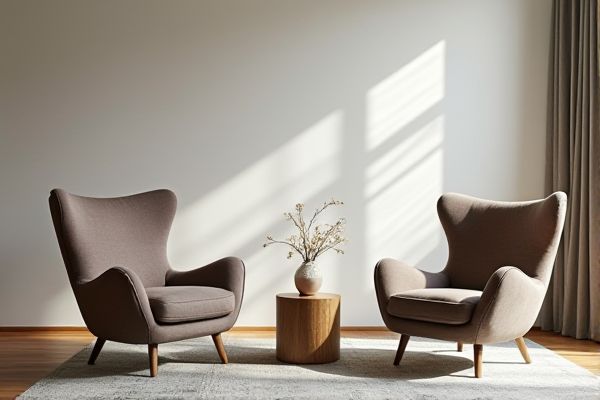
A tight back chair features upholstery that is firmly attached to the frame, offering a sleek and tailored look with firm support, while a loose back chair has a removable cushion that provides more adjustability and ease of cleaning. Discover the key differences and which style best suits Your comfort and decor preferences by reading the full article.
Table of Comparison
| Feature | Tight Back Chair | Loose Back Chair |
|---|---|---|
| Back Cushion | Upholstered directly to frame, no removable cushions | Removable, loose back cushions for added comfort |
| Support | Firm, structured support due to fixed upholstery | Soft, adjustable support with loose cushions |
| Maintenance | Easy cleaning, no cushion shifting | Requires frequent fluffing and repositioning of cushions |
| Style | Formal, tailored appearance | Casual, relaxed look |
| Durability | More durable due to fixed fabric | Potential fabric wear on loose cushions |
| Comfort Level | Moderate firmness | Higher softness and flexibility |
| Price Range | Generally more affordable | Often higher due to added cushion materials |
Introduction to Tight Back vs Loose Back Chairs
Tight back chairs feature upholstery firmly attached to the frame, providing a structured, sleek appearance and consistent support ideal for formal settings. Loose back chairs have removable, cushioned covers that offer a relaxed, customizable feel, making them suitable for casual or versatile spaces. Choosing between tight back and loose back chairs depends on desired aesthetics, ease of maintenance, and comfort preferences.
Defining Tight Back Chairs
Tight back chairs feature upholstery that is firmly attached to the frame, providing a sleek and tailored appearance without any visible seams or cushions. This design offers consistent support and a streamlined look, ideal for modern and minimalist interiors. Your choice of a tight back chair ensures durability and easy maintenance compared to loose back chairs, which have removable cushions.
What Are Loose Back Chairs?
Loose back chairs feature a detachable or loose cushion on the backrest, offering enhanced comfort and versatility compared to tight back chairs, which have a fixed, upholstered back. These chairs allow for easier cleaning and pillow replacement, making them ideal for dynamic living spaces where style and functionality matter. Your choice between the two depends on whether you prioritize a tailored look or adaptable comfort in your seating.
Comfort Comparison: Tight Back vs Loose Back
Tight back chairs provide firm, consistent support, ideal for maintaining proper posture and preventing slouching during extended seating periods. Loose back chairs offer enhanced flexibility and cushioning, adapting to various body shapes and movements for a softer, more relaxed seating experience. Choosing between tight back and loose back chairs depends on individual comfort preferences and intended usage, with tight backs favoring structure and loose backs prioritizing plushness.
Aesthetic Differences Between Chair Types
Tight back chairs feature a clean, tailored appearance with upholstery stretched firmly over the frame, creating a sleek and modern aesthetic that complements minimalist or contemporary interiors. Loose back chairs offer a more relaxed and casual look, with removable cushions that add softness and layered texture, ideal for traditional or cozy living spaces. Your choice between these chair types will significantly impact the room's visual appeal, balancing structure with comfort.
Maintenance and Cleaning Considerations
Tight back chairs typically have a fixed upholstery that resists sagging and simplifies maintenance, making cleaning easier as there are fewer crevices for dust and debris to accumulate. Loose back chairs feature removable cushions and slipcovers, allowing you to deep clean or replace covers as needed, which is ideal for high-traffic areas or homes with pets. Choosing between these styles depends on your preference for convenience in upkeep versus flexibility in cleaning options.
Durability and Longevity
Tight back chairs offer enhanced durability due to their firmly upholstered back panels that resist sagging and maintain shape over time, making them ideal for long-term use. Loose back chairs, featuring removable cushions, provide flexibility but may require frequent fluffing and replacement, impacting their overall longevity. Choosing a tight back chair ensures your seating investment remains sturdy and visually appealing for years, minimizing maintenance needs.
Best Uses and Ideal Spaces
Tight back chairs provide firm support and are ideal for formal living rooms, offices, or dining areas where structured seating is preferred. Loose back chairs offer a relaxed, casual fit, perfect for family rooms, lounges, or spaces designed for comfort and frequent use. Choosing between the two depends on the desired aesthetic and the level of comfort needed in the specific environment.
Cost Comparison: Which Is More Affordable?
Tight back chairs generally cost less than loose back chairs due to their simpler construction and fewer materials required for upholstery. Loose back chairs involve separate cushions, adding to production and replacement expenses, which increases their overall price. For budget-conscious buyers, tight back chairs offer a more affordable option without compromising on style or comfort.
How to Choose the Right Chair for Your Space
Choosing the right chair for your space depends on comfort preferences and design needs; a tight back chair offers a structured, sleek appearance with firm support, ideal for formal settings or smaller rooms. In contrast, a loose back chair features detachable cushions, providing a relaxed, casual vibe and easier maintenance, perfect for versatile or high-traffic areas. Consider your lifestyle, room dimensions, and whether you prioritize firm support or plush comfort to ensure your chair enhances both function and style.
 homyna.com
homyna.com